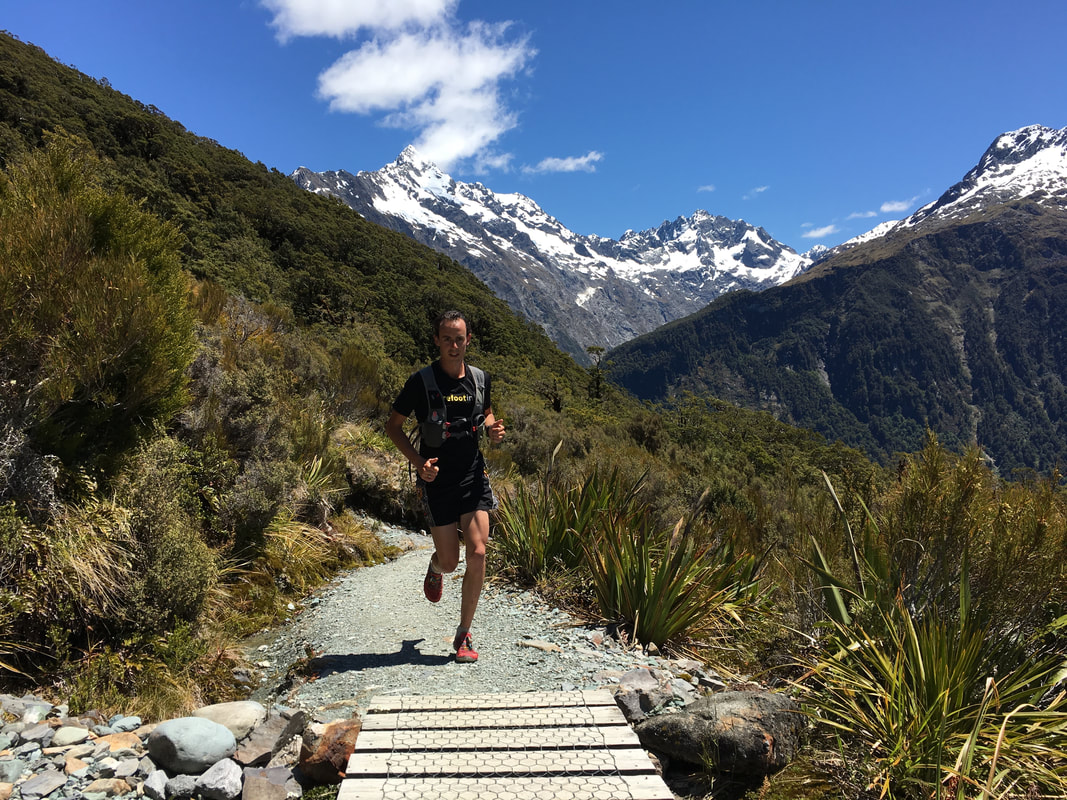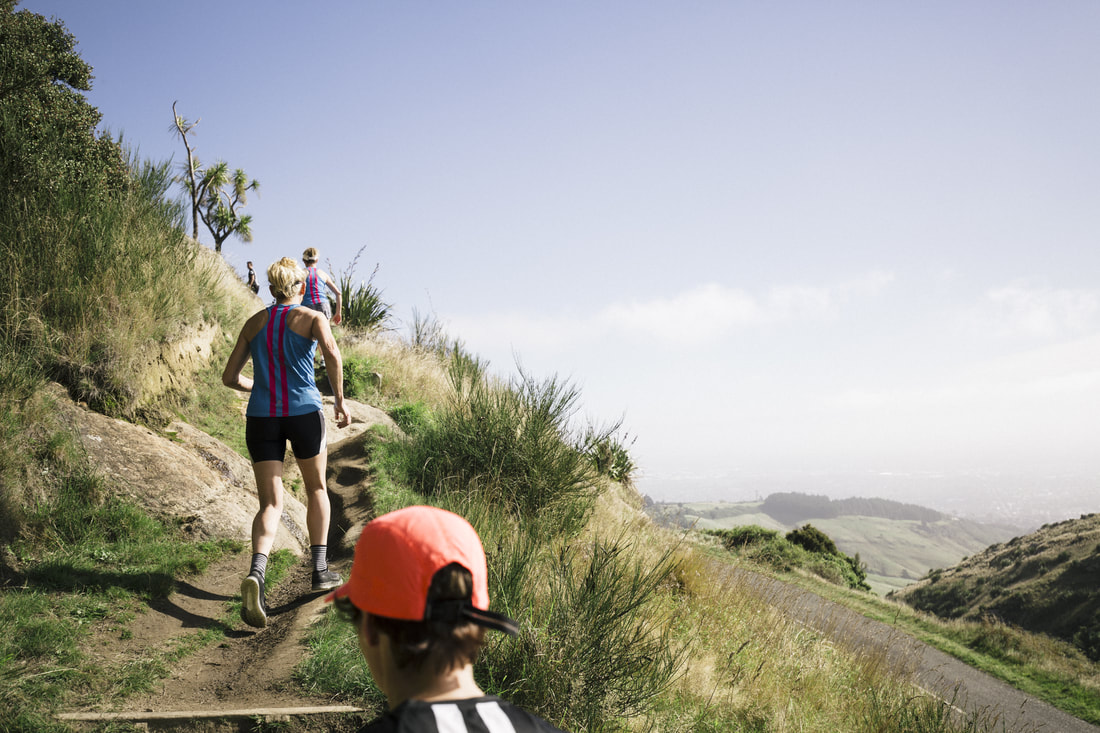Kiwi Trail Running Article
Written By: Matt Rayment
Trail Tips is our new segment we speak to James Kuegler about strategies to make your running more efficient. This issue, we discuss climbing and descending- two key components of trail running and facets of the sport that cause people difficulty. Uphills will always hurt, but being as efficient as possible will allow you to A) Get up the hill quicker and in better shape B) Have more in the tank for the downhill.
Written By: Matt Rayment
Trail Tips is our new segment we speak to James Kuegler about strategies to make your running more efficient. This issue, we discuss climbing and descending- two key components of trail running and facets of the sport that cause people difficulty. Uphills will always hurt, but being as efficient as possible will allow you to A) Get up the hill quicker and in better shape B) Have more in the tank for the downhill.
UPHILL
The default position for many people when they are climbing a steep hill is to walk with a long stride, marching up the hill, hinged over at the hips, loading up through their quadriceps and calves. Generally, the foot is on the ground for a longer time and the foot is planted forward of the centre of gravity. The upper body is bent over, into the hill, the person’s eyes forward to the trail.
If the person is able to run uphill, the stride is usually longer, the upper body hinges over the hips and the load is taken through the quadricep and calves.
Both these positions are less efficient than ideal. First- they load up the the calves and quadriceps with effort, thus increasing the likelihood of premature fatigue, cramp and injury.
Second- having the the upper body bent over towards the incline can fatigue your lower back and hips, it reduces your scope of vision as your head is pointed down the trail.
Third- having the upper body bent over decreases your lung capacity as it closes down your chest wall and can restrict your diaphragm.
A MORE EFFICIENT STANCE
I would suggest that consider moving uphill like you would a gear ratio. The lower the gear is the more turnover you get. Smaller, lighter foot falls increase your efficiency and are helpful in the long term.
First off, your stance needs to be as upright as possible, think tall, relaxed and proud. Eyes looking mainly up the trail, not mainly down at your feet. Keep your footfalls as light as possible and aim to have them as underneath you as possible. In this way your foot will fall closest to your centre of gravity. Aim for the highest number of footfalls you can, in this way, there is not massive strain put through the quadriceps and calves.
Second- this upright stance will allow you to engage your gluteal muscles and hamstrings. Drive your step forward with your knee. In this way it is easier to transition into a trot if the gradient of the hill evens out and you are able to move forward at a faster pace.
Third- Elbows back, arm cadence as high as you can (as fast as your arms move, your feet will). Having your elbows back further opens your chest and allows increased lung capacity. Keep your hands relaxed, don’t drive forward with them. They should only come as far forward as your feet do.
How Do You Attack An Uphill?
Intensity, Intensity, Intensity. It all comes down to efficiently managing your intensity. Think about a primary school cross country. Most kids SPRINT then walk, then SPRINT again. You don’t want to be doing that. Keep the intensity of your climbing consistent, for many of us, depending on the climb that will mean periods of walking. An efficient transition between the two will save more energy than drilling yourself for a third of a hill and then gasping and staggering for the other two thirds.
The default position for many people when they are climbing a steep hill is to walk with a long stride, marching up the hill, hinged over at the hips, loading up through their quadriceps and calves. Generally, the foot is on the ground for a longer time and the foot is planted forward of the centre of gravity. The upper body is bent over, into the hill, the person’s eyes forward to the trail.
If the person is able to run uphill, the stride is usually longer, the upper body hinges over the hips and the load is taken through the quadricep and calves.
Both these positions are less efficient than ideal. First- they load up the the calves and quadriceps with effort, thus increasing the likelihood of premature fatigue, cramp and injury.
Second- having the the upper body bent over towards the incline can fatigue your lower back and hips, it reduces your scope of vision as your head is pointed down the trail.
Third- having the upper body bent over decreases your lung capacity as it closes down your chest wall and can restrict your diaphragm.
A MORE EFFICIENT STANCE
I would suggest that consider moving uphill like you would a gear ratio. The lower the gear is the more turnover you get. Smaller, lighter foot falls increase your efficiency and are helpful in the long term.
First off, your stance needs to be as upright as possible, think tall, relaxed and proud. Eyes looking mainly up the trail, not mainly down at your feet. Keep your footfalls as light as possible and aim to have them as underneath you as possible. In this way your foot will fall closest to your centre of gravity. Aim for the highest number of footfalls you can, in this way, there is not massive strain put through the quadriceps and calves.
Second- this upright stance will allow you to engage your gluteal muscles and hamstrings. Drive your step forward with your knee. In this way it is easier to transition into a trot if the gradient of the hill evens out and you are able to move forward at a faster pace.
Third- Elbows back, arm cadence as high as you can (as fast as your arms move, your feet will). Having your elbows back further opens your chest and allows increased lung capacity. Keep your hands relaxed, don’t drive forward with them. They should only come as far forward as your feet do.
How Do You Attack An Uphill?
Intensity, Intensity, Intensity. It all comes down to efficiently managing your intensity. Think about a primary school cross country. Most kids SPRINT then walk, then SPRINT again. You don’t want to be doing that. Keep the intensity of your climbing consistent, for many of us, depending on the climb that will mean periods of walking. An efficient transition between the two will save more energy than drilling yourself for a third of a hill and then gasping and staggering for the other two thirds.
DOWN HILL.
This is the fun part. Many of the same principles apply in terms of stance as running uphill, you should be as upright, relaxed and proud as possible. Your stride will naturally lengthen but focus on a high leg turn over with shorter strides than long lunges. Aim to land on the front/mid part of your foot. Keep your eyes up and look where you want to go, not where you don’t.
In terms of stability and efficiency, I think about “Keeping the weight over my skis”. You don’t want to be leaning so far back that you become unstable, this will also slow you down. You can control your speed with your body posture. Want to go faster? Lean your weight slightly forward. To slow down, lean further back.
Running down hill we should be using our hands as much as possible, for balance and to grab onto things for support if need be.
Working with Camber
Again, to take it back to a skiing analogy, work from left to right, running off face and then on face. Zig Zagging down hill in this manner keeps your momentum up, allows you to conserve some energy as you are not barrelling straight forward and will allow you to view and attack most obstacles from a more considered position.
When The Going Gets Rough
When a trail turns very technical, with lots of obstacles and trail furniture, Pause/Step/Pause is the way to go. Run up to the obstacle, take two steps, pause, assess the best way down, and continue. More experienced runners may be able to see the flow of a trail or to see the best lines down, there is nothing wrong with anybody, be they beginner or proficient, pausing to assess risk and make their way down safely and in a considered manner. I would rather you got down a trail in one piece that bust yourself racing for a Strava Crown.
This is the fun part. Many of the same principles apply in terms of stance as running uphill, you should be as upright, relaxed and proud as possible. Your stride will naturally lengthen but focus on a high leg turn over with shorter strides than long lunges. Aim to land on the front/mid part of your foot. Keep your eyes up and look where you want to go, not where you don’t.
In terms of stability and efficiency, I think about “Keeping the weight over my skis”. You don’t want to be leaning so far back that you become unstable, this will also slow you down. You can control your speed with your body posture. Want to go faster? Lean your weight slightly forward. To slow down, lean further back.
Running down hill we should be using our hands as much as possible, for balance and to grab onto things for support if need be.
Working with Camber
Again, to take it back to a skiing analogy, work from left to right, running off face and then on face. Zig Zagging down hill in this manner keeps your momentum up, allows you to conserve some energy as you are not barrelling straight forward and will allow you to view and attack most obstacles from a more considered position.
When The Going Gets Rough
When a trail turns very technical, with lots of obstacles and trail furniture, Pause/Step/Pause is the way to go. Run up to the obstacle, take two steps, pause, assess the best way down, and continue. More experienced runners may be able to see the flow of a trail or to see the best lines down, there is nothing wrong with anybody, be they beginner or proficient, pausing to assess risk and make their way down safely and in a considered manner. I would rather you got down a trail in one piece that bust yourself racing for a Strava Crown.






